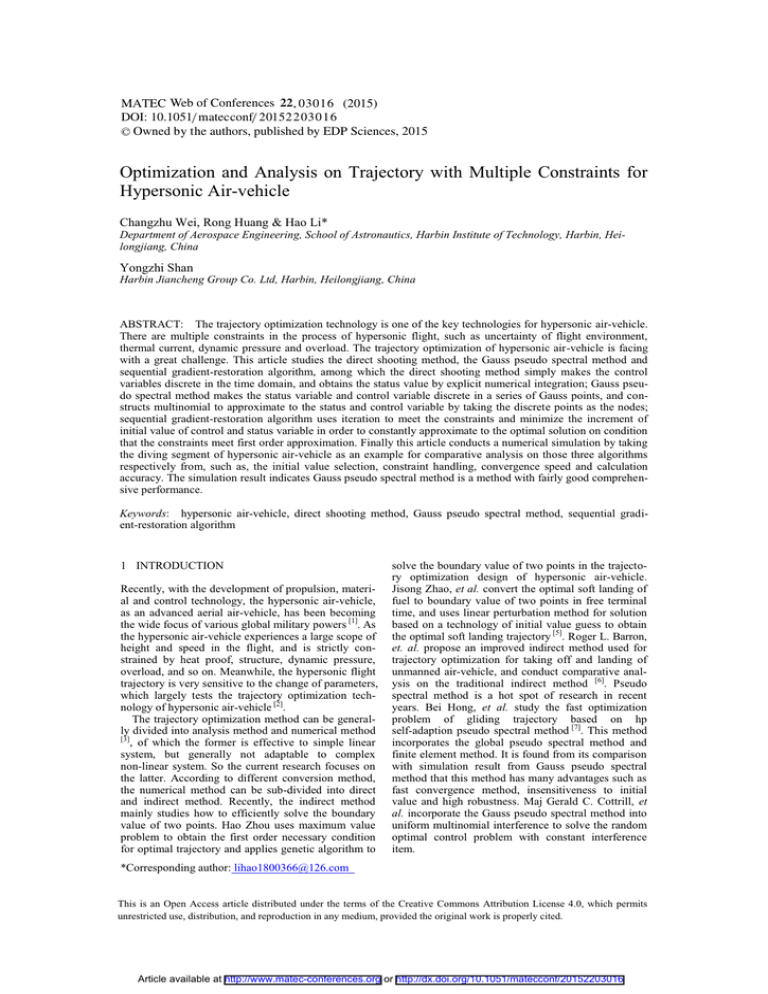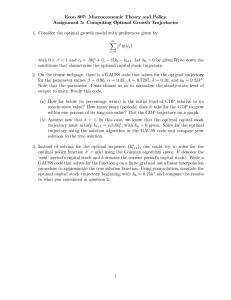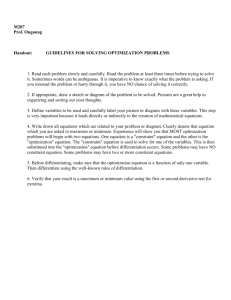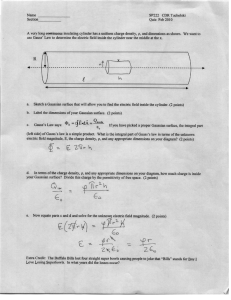Optimization and Analysis on Trajectory with Multiple Constraints for Hypersonic Air-vehicle
advertisement

MATEC Web of Conferences 22 , 030 1 6 (2015) DOI: 10.1051/ m atec conf/ 2015 2 2030 1 6 C Owned by the authors, published by EDP Sciences, 2015 Optimization and Analysis on Trajectory with Multiple Constraints for Hypersonic Air-vehicle Changzhu Wei, Rong Huang & Hao Li* Department of Aerospace Engineering, School of Astronautics, Harbin Institute of Technology, Harbin, Heilongjiang, China Yongzhi Shan Harbin Jiancheng Group Co. Ltd, Harbin, Heilongjiang, China ABSTRACT: The trajectory optimization technology is one of the key technologies for hypersonic air-vehicle. There are multiple constraints in the process of hypersonic flight, such as uncertainty of flight environment, thermal current, dynamic pressure and overload. The trajectory optimization of hypersonic air-vehicle is facing with a great challenge. This article studies the direct shooting method, the Gauss pseudo spectral method and sequential gradient-restoration algorithm, among which the direct shooting method simply makes the control variables discrete in the time domain, and obtains the status value by explicit numerical integration; Gauss pseudo spectral method makes the status variable and control variable discrete in a series of Gauss points, and constructs multinomial to approximate to the status and control variable by taking the discrete points as the nodes; sequential gradient-restoration algorithm uses iteration to meet the constraints and minimize the increment of initial value of control and status variable in order to constantly approximate to the optimal solution on condition that the constraints meet first order approximation. Finally this article conducts a numerical simulation by taking the diving segment of hypersonic air-vehicle as an example for comparative analysis on those three algorithms respectively from, such as, the initial value selection, constraint handling, convergence speed and calculation accuracy. The simulation result indicates Gauss pseudo spectral method is a method with fairly good comprehensive performance. Keywords: hypersonic air-vehicle, direct shooting method, Gauss pseudo spectral method, sequential gradient-restoration algorithm 1 INTRODUCTION Recently, with the development of propulsion, material and control technology, the hypersonic air-vehicle, as an advanced aerial air-vehicle, has been becoming the wide focus of various global military powers [1]. As the hypersonic air-vehicle experiences a large scope of height and speed in the flight, and is strictly constrained by heat proof, structure, dynamic pressure, overload, and so on. Meanwhile, the hypersonic flight trajectory is very sensitive to the change of parameters, which largely tests the trajectory optimization technology of hypersonic air-vehicle [2]. The trajectory optimization method can be generally divided into analysis method and numerical method [3] , of which the former is effective to simple linear system, but generally not adaptable to complex non-linear system. So the current research focuses on the latter. According to different conversion method, the numerical method can be sub-divided into direct and indirect method. Recently, the indirect method mainly studies how to efficiently solve the boundary value of two points. Hao Zhou uses maximum value problem to obtain the first order necessary condition for optimal trajectory and applies genetic algorithm to *Corresponding author: lihao1800366@126.com solve the boundary value of two points in the trajectory optimization design of hypersonic air-vehicle. Jisong Zhao, et al. convert the optimal soft landing of fuel to boundary value of two points in free terminal time, and uses linear perturbation method for solution based on a technology of initial value guess to obtain the optimal soft landing trajectory [5]. Roger L. Barron, et. al. propose an improved indirect method used for trajectory optimization for taking off and landing of unmanned air-vehicle, and conduct comparative analysis on the traditional indirect method [6]. Pseudo spectral method is a hot spot of research in recent years. Bei Hong, et al. study the fast optimization problem of gliding trajectory based on hp self-adaption pseudo spectral method [7]. This method incorporates the global pseudo spectral method and finite element method. It is found from its comparison with simulation result from Gauss pseudo spectral method that this method has many advantages such as fast convergence method, insensitiveness to initial value and high robustness. Maj Gerald C. Cottrill, et al. incorporate the Gauss pseudo spectral method into uniform multinomial interference to solve the random optimal control problem with constant interference item. This is an Open Access article distributed under the terms of the Creative Commons Attribution License 4.0, which permits unrestricted use, distribution, and reproduction in any medium, provided the original work is properly cited. Article available at http://www.matec-conferences.org or http://dx.doi.org/10.1051/matecconf/20152203016 MATEC Web of Conferences Assign an initial value We get (dk,¬k+1) Target function and constraint Calculation of function value Update the penalty factor Calculation of partial derivative yes Judge whether it is converged Search and get ¢ using Watchdog technology End No Solve the sub-problem of secondary planning Whether it has a solution No We get xk+1 Solve the subproblem of another secondary planning Update Bk Yes Figure 1. Algorithm procedure of direct shooting method + secondary planning of sequence To compare the merits, flaws and adaptation of different optimization algorithm, this article uses respectively direct shooting method, Gauss pseudo spectral method in the direct method and sequential gradient-restoration algorithm in the indirect method to conduct an optimization analysis on minimum time problem in the diving segment of hypersonic air-vehicle, and comprehensively considers multiple constraints such as dynamic pressure, overload, angle of attack and route angle of terminal flight. tion-type performance index function, and its integrand is L( x, u, p, t ) . In this equation set(2), there are equation of system status, equation constraint, inequality constraint, initial condition of status variable and terminal condition of status variable and parameter. 3 DESCRIPTION OF NUMERICAL OPTIMIZATION ALGORITHM 3.1 Direct shooting method + secondary planning of sequence 2 GENERAL DESCRIPTION OF OPTIMAL CONTROL PROBLEM The general optimal control problem can be described as: determine the allowable control u(t ) R m and parameters p R n to transit a system confirmed by a differential equation set from a given initial status to terminal status, minimize the performance index function J and meet the specified constraints. Its mathematic description is ast follows: f (1) J ( x(t f ), p) L( x, u, p, t )dt p t0 x f ( x, u, p, t ), t [t0 , t f ]; c( x, u, p, t ) 0; d ( x, u, p, t ) 0; (2) x(t0 ) x0 ; ( x(t f ), p) 0 Among which, x(t ) R n is a status variable of system, t a time variable. The performance index function J is composed of ending-value-type performance index function ( x(t f ), p) and integra- The direct shooting method is the most common one in the direct method that simply makes the control variables discrete in the time domain; obtains the status value by explicit numerical integration and further obtains the performance index and constraint value. However, due to its sensitiveness to initial value and great computational burden, each time of iteration requires integration for the status variable, and it is just suitable for optimal control problem with less requirement of accuracy. The direct shooting method can be used to approximately convert the optimal control problem in finite dimension to non-linear planning problem, and use secondary planning of sequence to solve the non-linear planning problem above. The detailed calculation procedure is as shown in the figure 1. 03016-p.2 ICETA 2015 Figure 2. Algorithm procedure of hp self-adaptation Gauss pseudo spectral method 3.2 Gauss pseudo spectral method Gauss pseudo spectral method is a direct point collocation method based on global interpolation multinomial and, compared to regular direct point collocation method, has less nodes and higher accuracy [9]. Gauss pseudo spectral method makes the status and control variable discrete in a series of Gauss points, and constructs Lagrange interpolation multinomial to approximate to the status and control variable by those discrete points. (1)Approximate status variable and control variable of global interpolation multinomial (confirmed Gauss points) Set K-order Legendre-Gauss pint and 0 1 as the nodes to construct K+1 Lagrange interpolation multinomial Li , i 0, , K , which will be taken as the primary function to construct approximate expression of status and control variable, namely: K x X Li x i (3) i 0 (2)Dynamics differential equation (confirmed Gauss differential matrix) The approximation of status variable can be realized by global interpolation multinomial, and the approximation of its derivative can be realized by derivation of Lagrange interpolation multinomial in order to convert the dynamics differential equation constraint to algebra constraint, which is: K K i 0 i 0 x k X k Li k X i Dki k X i (2) K D X i 0 ki k t f t0 i 2 f X k , U k , k ; t0 , t f 0, k 1, ,K (3) (3)Terminal status constraint (confirmed Gauss weight) The optimal control problem generally includes terminal status constraint. Make the terminal constraint discrete and use Gauss integration for approximation, and then we get: X f X 0 t f t0 2 K w f X , U , k k 1 k k k ; t0 , t f (6) (4) Approximation of performance index function Approximate the integration item in Bolza-type performance index function with Gauss integration and the performance index function will be obtained: J X 0 , t0 , X f , t f t f t0 2 K w g X , U , k 1 k k k k ; t0 , t f (7) (5) hp self-adaptation Gauss pseudo spectral method hp self-adaptation Gauss pseudo spectral method uses double-layered strategy to determine the number of collocation points in each refined segment and the order of interpolation multinomial to meet the customized accuracy requirement from users. The selec- 03016-p.3 MATEC Web of Conferences tion of interpolation multinomial on each segment is the same as that for gauss pseudo spectral method. hp self-adaptation Gauss pseudo spectral method incorporates the advantages of Gauss pseudo spectral method and hp-type self-adaptation finite element method that allows refinement of segments, and the length h of segment and the order p of interpolation multinomial will be changed according to the need in iteration process. Compared to gauss pseudo spectral method, this method costs less calculation time and memory occupancy but gets more accurate solution. A x A u B C ( x ) 0; 0 A 0; B S ; T u 0 xT S xT 0; T u S x A Su B S C S 0; C S dt 1 T T 0 T x 1 x A C 0 1 0; 0 t 1 Therefore, we can definitely reduce Pe to the certain accuracy by a certain method to constantly solve the equation (11) and reasonably search the restoration step length a . (3) Assessment function Assuming the squared norm of vector a as N (a ) , that is, N (a) aT a , we define the Pe and Qe functions as follows: 4 SEQUENTIAL GRADIENT-RESTORATION ALGORITHM Pe N ( x )dt N ( S )dt N ( 1 ) Sequential gradient-restoration algorithm is composed of gradient and restoration. This method uses uniform optimal conditions without deduction of adjoint equation and transversal condition, which facilitates the realization of modularization. Meanwhile, due to the restoration stage, this method is insensitive to initial value. (1) Approximation of first order gradient Assuming that the status variable of x (t ) , control variable of u(t ) , parameter of all meet the general solution of optimal control problem, then x (t ) , u(t ) and are their increments respectively relative to the optimal solution. Now we define the vector A , vector B and vector C as follows: A x a , B u a , C a (4) Then we obtain the approximation model of first order gradient for the optimal control problem in previous section according to Euler equation and first order variation, which is: Qe N ( f x xT S xT )dt N ( f u uT SuT )dt A x A u B C 0; S x A S u B S C 0; x A C 1 0 (9) 1 A 0 0; B f u uT SuT ; C f T ST dt g 1 0 f x xT S xT 0; g x xT 0; 0 t 1 1 As given a status variable, control variable and parameter that meet the status equation and constraint, and solving the equation (9), we may obtain A(t ) , B(t ) , C and Lagrange multiplier (t ) , (t ) and ; then we confirm the gradient step length a by reasonable searching method to reduce the target function value in order to obtain the new status variax((t ) , control variable u u((t ) and parameter , ble x and then constantly approximate to the optimal solution. (2) Restoration method Assuming the status variable of x (t ) , control variable of u (t ) and parameter of cannot meet the status equation and constraint within a certain accuracy scope. Now we define the vector A , vector B and vector C as follows: A x a , B u a , C a (5) Where, a is the restoration step length. We may also get the corresponding restoration model according to first order variation and optimal control theory as follows: (11) 1 1 1 0 0 1 1 0 0 (7) (13) N ( f T ST )dt ( g T ) N g x Tx 1 1 0 1 Where, Pe and Qe represent respectively the satisfaction condition of constraint and optimal condition, and there will be Pe 0 and Qe 0 for accurate solution. When we are using approximation method to solve the optimal control problem, there will be Pe 1 and Qe 2 , where, the 1 and 2 are both the minimum. (4) Treatment of control variable and constraint Angle of attack of , angle of heel of and fuel equivalence ratio of are generally regarded as the optimal control variables. As the current sequential gradient-restoration algorithm can only deal with the equation constraint, and the introduction of auxiliary control variable can convert its inequality to equation constraint, which is: 1 1 max min max min sin u1 2 2 (14) Where, u1 is the auxiliary control variable of angle of attack, and the treatment method is the same as that for angle of heel and fuel equivalence ratio. As the process constraint obviously contains the control variable, the algorithm will have a strong robustness and convergence. As the process constraint S does not obviously contain the control variable, the algorithm will not ensure its convergence, so we shall reasonably convert the process constraint. As the dynamic pressure constraint is an inequality constraint obviously without control variable, it shall be converted to equation constraint obviously with control variable. Introduce the auxiliary status variable , and of y and auxiliary control variable of meanwhile conduct the non-dimensionalization, we may obtain: qmax 1 1 r rV V 2 VV V 2 y 0; y ; y((0) V 2 (15) 2 r0 2 The overload constraint obviously contains control(6) variable, so we may simply convert it to equation constraint. Introduce the auxiliary control variable o and non-dimensionalize it, and then we may obtain: 03016-p.4 ICETA 2015 Table 1. Constraint conditions of simulated initial parameters Name of variable Numerical value Initial speed Initial height Initial heel angle of trajectory Initial quality Constraint on heel angle of terminal trajectory 1950.0 m/s 28.0 km 0.0° 1600.0kg -90°̚-70° Name of variable Terminal height constraint Dynamic pressure constraint Overload constraint Constraint on angle of attack Constraint on change rate of angle of attack Numerical value 0.0 km 800 kPa 13.5 -6°̚8° 2°/s Figure 3. Change curve of angle of attack Figure 4. Change curve of route angle of flight 03016-p.5 MATEC Web of Conferences Figure 5. Change curve of Mach number Figure 6. Change curve of height N nmax mg0 r o 2 0 2 0 (16) V X / m g sin ! ! Y cos / (mV ) g cos ! / V V cos ! / r Y sin / (mV cos ! ) V cos ! sin tan / r (17) r V sin ! 5 OPTIMIZATION MODEL OF TRAJECTORY WITH MULTIPLE CONSTRAINTS IN THE DIVING SEGMENT " V cos ! sin / (r cos ) Non-dimensionalization motion equation [11] of unpowered diving segment for hypersonic air-vehicle in positional coordinates is as follows: V cos ! cos / r Where, V represents the speed of air-vehicle, r the geocentric radius, ! the route angle of flight, the path angle, " the geocentric longitude, 03016-p.6 ICETA 2015 the geocentric latitude. In the non-dimensionalization process, we take the non-dimensionalization factor of geocentric distance and time as respectively re and re ge ; the non-dimensionalization of angle and quality is not necessary. Ignoring the earth rotation and oblateness, the American standard atmosphere model USSA76 is taken as the atmosphere model. 6 NUMERICAL SIMULATION In terms of the given optimization model of trajectory with multiple constraints in the diving segment of hypersonic air-vehicle, we use the direct shooting method, Gauss pseudo spectral method and sequential gradient-restoration algorithm respectively to solve the minimum time problem, where the parameters planning problem obtained by conversion from direct shooting method and Gauss pseudo spectral method is solved by secondary planning of sequence. The detailed simulation parameters are displayed in table 1. Simulation result is in figure 3-6: It is concluded from the simulation result above: 1. Though easily realized, the direct shooting method is sensitive to initial value with slow convergence speed and low accuracy; 2. The gradient-restoration algorithm is a trajectory optimization method based on gradient calculation with high calculation speed and high convergence accuracy; 3. The gradient-restoration algorithm is sensitive to the non-linear of model, and the non-linear change of model parameters will generally lead the gradient solution of algorithm to emerge singular point, which makes the curve of simulation result have cusp point; 4. The gradient-restoration algorithm currently cannot efficiently treat the change rate constraint of control variable, whereas the direct shooting method and Gauss pseudo spectral method does not have this problem, and Gauss pseudo spectral method has the smoothest curve; 5. The discrete Gauss point of Gauss pseudo spectral method is a relatively complex process that requires initial value generator. The consequent planning method of solution is relatively simple, and the initial value selection of gradient-relative algorithm is the simplest. 7 CONCLUSION This article first introduces the basic categorization of trajectory optimization method and general description of optimal control problem, fully introduces the direct shooting method, Gauss pseudo spectral method in direct method and principle of procedure of sequential gradient-restoration algorithm in the indirect method, gives optimization model of trajectory with multiple constraints in the diving segment of hypersonic air-vehicle and finally use those three methods for numerical simulation analysis by taking the diving segment of hypersonic air-vehicle as the background. It is found from the simulation result that Gauss pseudo spectral method is better than the other two algorithms in the initial value selection, constraint treatment, calculation speed, convergence accuracy, and so on. The improvement of optimization algorithm is not only related to the algorithm itself, but also in close relation to the improvement of the procedure realization mode, initial value selection and QP algorithm as well as the optimized objective, model, and so on. Therefore, as we conduct research on and realize the trajectory optimization technology, the knowledge of comprehensive mathematics, computer, background object and other fields is required. We shall consider the universality and also its specialty in order to constantly increase the efficiency, accuracy and applicability of trajectory optimization algorithm. REFERENCES [1] M.K.Lockwood, D.H.Petley. & J.L.Hunt, et al. 1996. Airbreathing Hypersonic Vehicle Design and Analysis Methods. AIAA96-0381. [2] Chen, X.Q. & Hou, Z.X. 2009. Multiple Purposes and Multiple Constraints Optimization for Reentry Trajectory of Hypersonic Gliding Air-vehicle. Journal of National University of Defense Technology, 31(6) [3] Chen, G., Fu, Y. & Guo, J.F. 2011. Summary of Trajectory Optimization Method for Air-vehicle. Flight Mechanics, 29 (4) [4] Zhou, H., Chen, W.C. & Yin, X.L. 2008. Optimization Design of Multiple Trajectories for Hypersonic Air-vehicle. Journal of Astronautics, 29(4) [5] Zhao, J.S., Gong, C.L. & GU, L.X.2008. Flight Path Optimization of Reentry Strike Air-vehicle with Power Space. Flight Mechanics, 26 (4) [6] Roger L Barro. & Cleon M Chick.2006. Improved Indirect Method for Air-Vehicle Trajectory Optimization. Journal of Guidance, Control, and Dynamics, 29(3). [7] Hong, B & Xin, W.Q. 2011. Fast Optimization Problem of Gliding Trajectory Based on Hp Self-adaption Pseudo Spectral Method. 30th China Annual Meeting of Mechanics, 06: 1956-1961 [8] Maj Gerald C. Cottrill, Lt Col Frederick G. Harmon. Hybrid Gauss Pseudo spectral and Generalized Polynomial Chaos Algorithm to Solve Stochastic Trajectory Optimization Problems. AIAA Guidance, Navigation and Control Conference, August 2011, Portland, Oregon [9] Yong, E.M., Tang, G.J. & Chen, L.2008. Fast Optimization of Reentry Trajectory for Hypersonic Air-vehicle Based on Gauss Pseudo Spectral Method. Journal of Astronautics, 29 (6) [10] Miele A, Damoulakis J N. &, Cloutier J R, et al.1974. Sequential Gradient-Restoration Algorithm for Optimal Control Problems with Nondifferential Constraints. Journal of Optimization Theory and Applications, 13(2): 218-255. [11] Jia, P.R., Chen, K.J., He. L. Long-range Rocket Ballistics. Changsha, National University of Defense Technology Press, 1993. 03016-p.7


